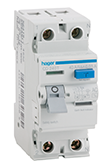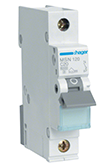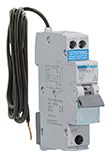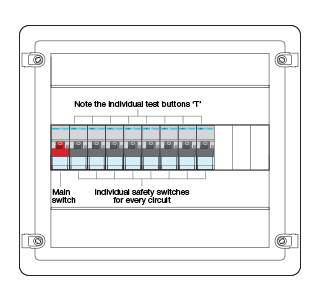Keeping you and your family safe
New rules mean safer homes

The Australian Standard Wiring Rules AS/NZS 3000:2018 governs all electrical work and every electrician in the country must comply with them.
Changes to the rules on 26th June 2018 means electrical contractors now need to complete some work differently.
The rules have changed to improve safety and reflect new technologies and products. As a global leader in electrical protection and safety switches, Hager has been an integral part of developing the changes alongside Standards Australia, in consultation with the industry.
Reducing risk with safety switches
A key change to safety switch requirements has been included in the new edition of the AS/NZS 3000:2018 wiring rules: a safety switch is now mandatory on all final sub-circuits in new domestic and residential installations.

RCDs Protect people
RCDs (Residual Current Devices) are safety switches designed to protect life from electrocution. In an event where a human comes in contact with the current, the safety switch will trip the power within milliseconds to save you or a member of your family from a potentially fatal electric shock.

Circuit breakers Protect against fire
RCDs must go hand in hand with miniature circuit breakers (Maximum 3 circuit breakers associated with 1 safety switch), which are designed to protect your family and home from the risk of fire. A miniature circuit breaker is an automatic electrical switch designed to cut power from a circuit in case of overloading or a short circuit. A typical risk is when too many appliances are plugged in to a power source, resulting in overheating of cables.

RCBOs Protect people and against fire
Some products already combine both functionalities in one compact device, like our RCBO (Residual current operated Circuit Breaker with Overcurrent protection) safety switch. They protect electrical circuits and more importantly, protect you from electrocution. Such products not only guarantee optimised safety but also isolate the fault to the only circuit affected, so there is no risk of a complete blackout.
What it means...

For your new build
The average Australian home has a minimum of two powerpoint circuits, two lighting circuits and a number of appliance specific circuits for hot water systems, air-conditioners and so on. Since 2018, safety switches are mandatory for all circuits without exception.
- Protecting each circuit with its own RCBO is the best option to guarantee optimised safety and also isolate the fault to the only circuit affected
- Protecting all circuits with a safety switch is now mandatory
- To ensure your installation has the minimum level of safety, check that at least two safety switches are installed in your property
- Safety switches are easily identifiable as they have a test button 'T'
For your existing home
Alterations and additionsThe installation of a safety switch is mandatory where any alteration to an existing circuit is undertaken
Switchboard replacement
Where all the circuit protection devices in a switchboard are replaced, additional protection by safety switches shall be provided for all the final sub-circuits supplied from that switchboard.
Repairs
For existing installations; where a single item of electrical equipment e.g. a powerpoint or a light switch, that is not protected by a safety switch, is replaced with an equivalent item in the same location, a safety switch need not be installed.
Call a licensed electrician
 It is important to engage a licensed electrician when performing any electrical works. Do not do it yourself. You or a family member could be seriously injured or killed if you undertake specialist tasks that require a licensed electrician, except for simple jobs which you can do yourself, such as:
It is important to engage a licensed electrician when performing any electrical works. Do not do it yourself. You or a family member could be seriously injured or killed if you undertake specialist tasks that require a licensed electrician, except for simple jobs which you can do yourself, such as:- changing an electric light bulb
- changing the starter in a fluorescent light fitting
- resetting a circuit breaker or safety switch
- test a safety switch with the test button 'T'